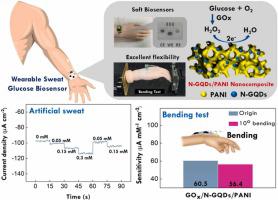Sensors and Actuators B: Chemical ( IF 8.0 ) Pub Date : 2023-03-04 , DOI: 10.1016/j.snb.2023.133617 Yu-Chi Lin , Mia Rinawati , Ling-Yu Chang , Yu-Xuan Wang , Yu-Ting Wu , Yi-Han Yen , Kuan-Jung Chen , Kuo-Chuan Ho , Min-Hsin Yeh

|
Understanding the levels change in biomarkers over time, especially glucose, is crucial for diabetics to inform early therapy. Recently, wearable sweat biosensors which operate in a non-invasive way have raised attention, providing continuous monitoring of the severity level. Nevertheless, the key challenges are that multiplexed motions may result in undesirable metal cracking by the rigid electrocatalytic layer, leading to decreased sensitivity and stability. In this work, we designed an N-GQDs anchored PANI matrix to realize flexible wearable biosensors with high detection accuracy. Upon the enhanced electron transfer by N-GQDs, N-GQDs/PANI nanocomposite offers greater sensitivity in H2O2 detection compared to pristine PANI, resulting in a sensitivity of 68.1 ± 1.11 and 44.06 ± 2.1 μA mM−1 cm−2, respectively. Moreover, after the glucose oxidase (GOx) immobilization, GOx/N-GQDs/PANI-based biosensors had shown excellent performance for glucose detection in artificial sweat. Precise glucose detection was also maintained after integrating into a flexible electrode, the sensitivity of the GOx/N-GQDs/PANI-based biosensor had retained 93.2 % with no apparent cracks in the morphology of the nanocomposite layer, compared to GOx/Pt-based one (71.3 %) toward glucose detection after a continuous bending test. Thus, the N-GQDs/PANI nanocomposite layer can provide reliable long-term monitoring with robust electrodes for non-invasive human sweat glucose monitoring on a wearable biosensor.
中文翻译:

具有柔性 N-GQDs/PANI 纳米复合层的非侵入式可穿戴汗液生物传感器用于葡萄糖监测
了解生物标志物水平随时间的变化,尤其是葡萄糖,对于糖尿病患者提供早期治疗信息至关重要。最近,以非侵入方式运行的可穿戴汗液生物传感器引起了人们的关注,它可以持续监测严重程度。然而,关键的挑战是多重运动可能会导致刚性电催化层产生不希望的金属开裂,从而导致灵敏度和稳定性降低。在这项工作中,我们设计了一个 N-GQDs 锚定 PANI 矩阵,以实现具有高检测精度的柔性可穿戴生物传感器。在 N-GQD 增强电子转移后,N-GQD/PANI 纳米复合材料在 H 2 O 2中提供更高的灵敏度与原始 PANI 相比,检测灵敏度分别为 68.1 ± 1.11 和 44.06 ± 2.1 μA mM −1 cm −2, 分别。此外,在葡萄糖氧化酶 (GOx) 固定化后,基于 GOx/N-GQDs/PANI 的生物传感器在人造汗液中的葡萄糖检测方面表现出优异的性能。集成到柔性电极后也能保持精确的葡萄糖检测,与基于 GOx/Pt 的生物传感器相比,基于 GOx/N-GQDs/PANI 的生物传感器的灵敏度保持 93.2%,纳米复合层的形态没有明显裂缝一个 (71.3 %) 在连续弯曲测试后用于葡萄糖检测。因此,N-GQDs/PANI 纳米复合层可以通过坚固的电极提供可靠的长期监测,用于在可穿戴生物传感器上进行无创人体汗液葡萄糖监测。











































 京公网安备 11010802027423号
京公网安备 11010802027423号